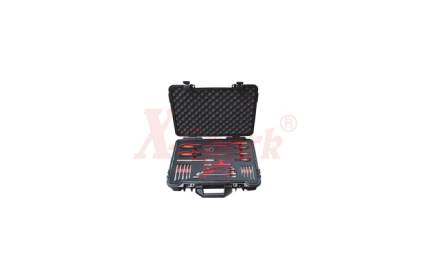The main metal material of explosion proof tools is copper alloy. There are many types of cast copper alloys, roughly divided by composition: cast pure copper and high-copper alloys, cast bronze, cast brass, cast copper-nickel alloy (copper copper). Cast pure copper has good electrical conductivity, thermal conductivity and wear resistance. Sometimes also add some trace elements (such as P, Sn, Zn, Mg, Fe, B, RE, etc.) and pure copper to form a high copper alloy, its performance is similar to pure copper. Engineering is used to calling them copper. The copper alloy with zinc as the main alloy element is called brass or ordinary brass.
All copper alloys that do not use zinc as the main alloying element are called bronze. Cast bronze is divided into tin bronze, aluminum bronze, beryllium bronze, nickel bronze (nickel bronze) according to its main alloy elements. Bronze has good wear resistance and high corrosion resistance. It has a low melting point, good casting performance, and good mechanical properties. Among them, aluminum bronze and beryllium bronze are collectively referred to as "safety tools" and "non-sparking tools" internationally, and collectively referred to as "explosion-proof tools" in China. On this basis, the multi-component alloy composed of other elements is called special brass, and its mechanical, physical and chemical properties have been significantly improved, which can meet the requirements of multiple uses. Cast brass can be divided into aluminum brass, silicon brass, manganese brass and lead brass according to the minor elements other than zinc.

Non Sparking Safety Tools
Explosion-proof type (explosion-proof tool)
Non sparking safety tools when the equipment is in normal operation, the components that can generate spark arcs are placed in the flameproof enclosure, which can withstand the internal explosion pressure without damage and can ensure the internal flame gas When propagating through the gap, the energy drop is not enough to detonate the gas outside the shell. The increased safety type will not produce arcs, sparks and dangerous high temperatures during normal operation. Further protective measures will be taken on the structure to improve the safety and reliability of the equipment.
Pouring type (explosion-proof tool)
The explosion-proof tool encapsulates the arc, spark or high temperature part that may ignite the explosive mixture, so that it cannot ignite the surrounding explosive mixture. The principle of explosion-proof electrical equipment ignites a flammable gas mixture for two reasons: one is the sparks and arcs generated by the electrical equipment, and the other is the surface heat of the electrical equipment. For the equipment that can generate arcs and sparks during normal operation, put it in a flameproof enclosure, or adopt other explosion-proof types such as potting type, sand-filling type, oil-filling type or positive pressure type to achieve the purpose of explosion-proof. Therefore, this device has no ignition source during normal operation, and can be used in an explosion-hazardous environment.
评论
发表评论